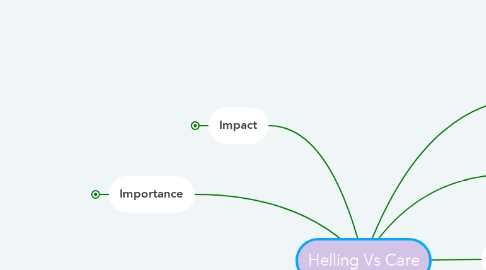
1. Impact
1.1. Harbeson v. Parke Davis, Inc.
1.1.1. The government appealed from a judgment of the United States District Court for the Western District of Washington, Jack E. Tanner, J., holding it liable for the failure of three doctors at an army medical center to respond to plaintiffs' inquiries by disclosing risks of anticonvulsant medication on unborn children.
1.1.1.1. Referred to holdings for basic negligence—breach of standard of the care determined by degree of care and skill expected of the average practitioner in the class to which the defendant belongs
1.2. U.S. v. De Leon-Reyna
1.2.1. Referred to holding because other officers failed to follow the word designation policy would not shield Officer Martinez from negligence.
2. Importance
2.1. The results of this trail greatly impact that medical community. Even with expert testimony that stated these physicians did act within standard of care, they are still held liable for not performing the pressure test to a patient. This means that physicians can be held accountable for not performing above their standard level of care.
3. Influence
3.1. Ophthalmologist
3.1.1. Ophthalmologist now know that despite the standard of care. If a patient, at any age, is exhibiting signs of glaucoma, then the pressure test should be administered.
3.2. Gynecologist
3.2.1. Mammograms follow a similar prescriptive age of 50. While Mammograms do come with some potential side effects, physicians should be cautious and watch for signs and family history.
4. Analysis Application
4.1. Courts Analysis
4.1.1. The patient had been examined by the Defendant for 9 years. Over the course of that time they had been addressing issues and symptoms related to the glaucoma.
4.1.2. Medical Expert testimony indicated that the standard of the profession do require pressure tests if the patient's complains and symptoms reveal to the physician that glaucoma could be suspected.
4.1.3. Although the risk of glaucoma is extremely rare in this age group, Helling is entitled to the same protection, as afforded to persons over 40, ... timely detection of the evidence of glaucoma
4.1.4. Carey testified that Helling probably had glaucome "ten years or longer". Which fell well within his time he had been seeing her as a patient.
4.1.5. Under the fact, reasonable prudence required the timely giving of the pressure test to this plaintiff.
4.1.6. That a greater duty of care would be imposed on the defendants than was established by their profession.
4.2. Carey Argument
4.2.1. Testimony of medical experts established that the standard of the profession of the specialty in the same or similar circumstances do not require routine pressure test for glaucoma upon patients under 40 years of age
4.2.2. That Carey was within a degree of care and skill which is expected of the average practitioner.
4.2.3. Carey argues that the standard of care is adequate to insulate the defendant from liability for negligence because the risk of glaucoma is so rare in this age group.
4.2.4. The defendant considered the Plantiff's visual problems to be related solely to complications associated with her contact lenses
4.2.5. The first time any complaint was made to the defendant about the Plantiff's field or visual field problems was Aug 30th
4.2.6. A pressure test was then scheduled on Oct 1, 30 days later.
5. Facts
5.1. Parties
5.1.1. Barbara Helling, plaintiff, patient of Dr. Casey and Dr. Laughlin
5.1.2. Dr. Thomas F. Carey, defendant, ophthalmologist
5.2. What Happened
5.2.1. Helling consulted the defendants for myopia in 1959 and was fitted for contacts
5.2.2. Sept, 1963- Helling consulted with the defendants concerning irritation caused by the contact lenses
5.2.3. Additional consultations occured in October, 1963; Feb, 1967; Sept, 1967; Oct, 1967; May, 1968; July 1968; Aug, 1968; and Sept, 1968
5.2.4. October, 1968- Helling consulted with Dr. Carey. Dr. Carey tested Helling's eye pressure for the first time. The test indicated that Helling has glaucoma.
5.2.4.1. Until this meeting, the defendants considered the plaintiff's visual problems to be related solely to complications with her contact lenses.
5.2.5. Helling, a 32 year old woman, had essentially lost her peripheral vision and her central vision was reduced to approximately 5 degrees vertical by 10 degrees horizontal.
5.2.6. Aug, 1969- Helling consulted with another physician.
5.3. Procedural history
5.3.1. August, 1969-Helling filed a complaint against the defendants alleging that she sustained severe and permanent damage to her eyes are a proximate result of the defendants negligence.
5.3.2. The Trial court entered judgement for the defendants following a defense verdict.
5.3.3. March, 1974- The case went to the Supreme Court of Washington.
5.3.4. The judgement of the trial court and the decision of the court of appeals is reversed, and the case is remanded for new trial on the issue of damages only
6. Issue
6.1. Whether there was sufficient evidence to support that Dr. Carey was not operating within the standard of care and whether or not that standard of care is adequate.
6.2. Whether a greater duty of care could be imposed on the defendants than was established by their profession.
7. Rule of Law
7.1. Negligence
7.1.1. unintentional failure to live up to accepted standards of behavior.
7.1.1.1. 4 essential elements to prove negligence: 1) duty of care, 2) breach of that duty, 3) injury, and 4) causation.
7.2. Strict Liability
7.2.1. imposes liability without showing of negligence. Those whose activities entail a high degree of risk to others.
